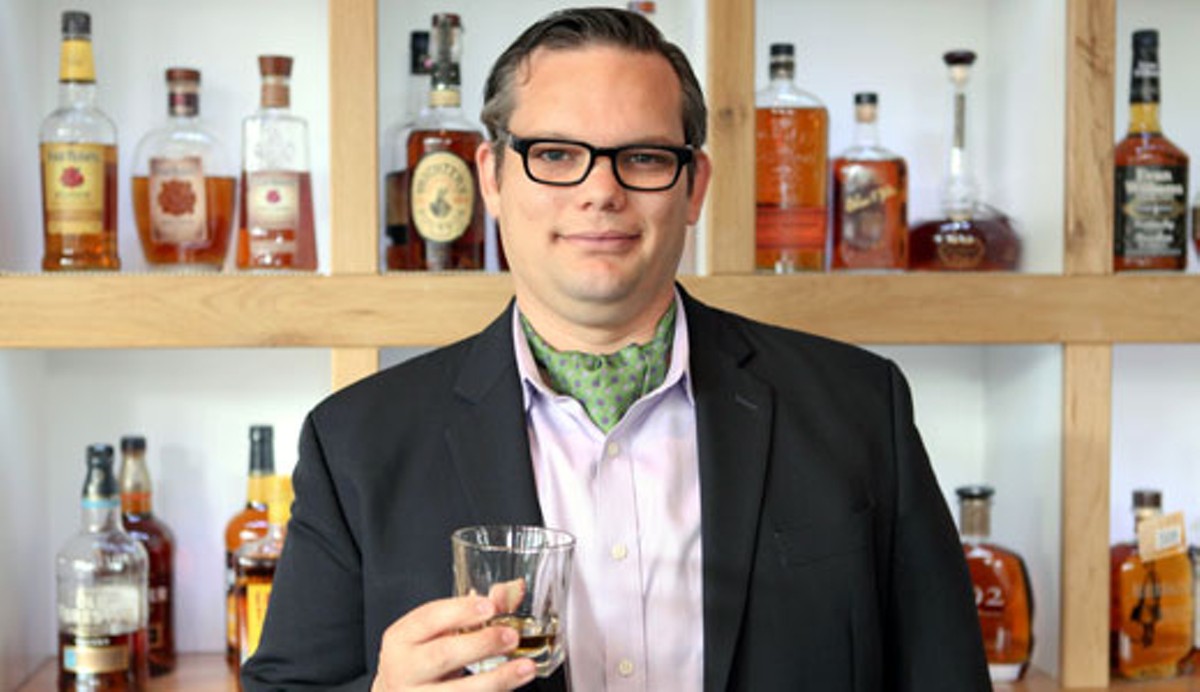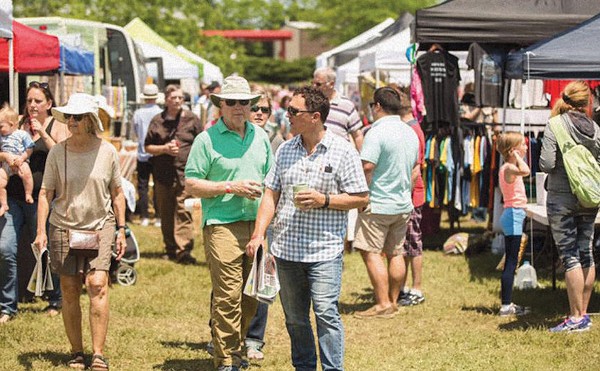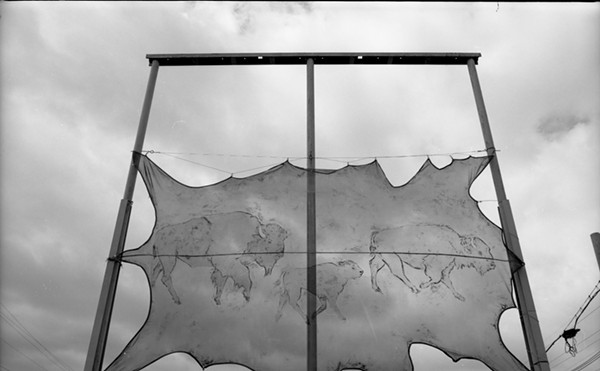Fred Minnick, clad in a blazer and signature ascot, holds up the glass of bourbon and peers through it.
“What you have in this glass,” he says, “is something that no other category of spirits does. They’re using new barrels every time; it’s all American. Most of it is made here in Kentucky. And it’s just got …”
He trails off for a moment, gathers his thoughts and continues, bringing the glass of caramel-brown bourbon back down to eye level.
“I mean, what’s not to love about it?”
He sniffs the bourbon deeply, and then takes a small sip.
“It has this sweet caramel, praline; it’s smooth,” he says. “There are so many good characteristics about bourbon that anybody who likes a distilled product, I feel like I could sell them on it.”
Minnick’s rise in the world of bourbon as a writer, author and all-around authority has a lot to do with his enthusiasm and energy, and not just when it comes to bourbon specifically. Minnick is always animated, has an infectious laugh like a sinister clown who has decided to turn good, and he often wears an impish grin that makes him come forth like a happy, precocious kid.
People simply gravitate toward Fred Minnick, and he loves being in the middle of social interaction. In fact, on the evening we conducted this interview, several of his bourbon-loving peers joined us, and Minnick, so excited to be hanging with friends and conversing about his favorite subject, lost his voice about midway into the session. (That he regained his voice before night’s end is testament to the healing powers of good bourbon.)
But this enthusiasm, along with his innate talent for telling a story and many other characteristics, is what has Minnick on top of the bourbon world, having just released his latest book, “Whiskey Women: The Untold Story of How Women Saved Bourbon, Scotch & Irish Whiskey,” and having just been named the Kentucky Derby Museum’s official “Bourbon Authority.”
Minnick already has a Wall Street Journal bestseller under his belt: “Camera Boy,” a book he wrote about his year as an Army journalist in Iraq, released in 2010. He also wrote the book “The Brand That Changed Beef: The Story of the Certified Angus Beef.” And he writes regular columns and stories for publications such as Tasting Panel, Covey Rise, The Bourbon Review, Whisky Advocate and Whisky Magazine.
When I first met Minnick, starting jobs at the same company together on the same day several years ago, we sat in a dull boardroom at a long table, enduring orientation at jobs we would both come to loathe. One of the corporate suits poured forth the company Kool-Aid, and while many of us sat silently wondering if we’d just committed professional suicide, it was Minnick who spoke up and challenged some of the claims the corporate suit was making.
I thought, “Wow. This guy has balls.”
Minnick simply tells it like it is. Like it, don’t like it — it doesn’t matter. But his words and observations are never mean-spirited; rather, it’s simply about getting to the heart of the truth.
“The thing I’m really impressed with most about him is his integrity,” says Minnick’s friend Michael Veach, a bourbon historian and Bourbon Hall of Fame member. “He’s not afraid to say what it really is — even if it’s something somebody may not like. He’s going to tell it like it is.”
Veach, author of the vaunted “Kentucky Bourbon Whiskey: An American Heritage,” recalls a bourbon panel in Chicago in which distillers and others were discussing craft distilling and flavored bourbons. “He said some things that probably didn’t make those craft distillers very happy,” Veach says, “but they were his opinions, so he came out and said them. And I respect that.”
In an industry that has a history of dirty dealings, Minnick is one of those who stands out as adding a needed splash of respect and dignity. He began writing about bourbon in 2007 and got his first regular bourbon column in 2010. He also was a well-respected wine writer at the time, but it was bourbon that drew him. And not just because it’s his preferred drink.
“When I was nominated for the International Wine Writer of the Year award and went to London and was surrounded by all these legendary wine writers,” Minnick says, “that’s when I realized I didn’t want to write about wine anymore. It’s hard to get samples and respect when you live in Kentucky. Writers in New York were getting samples three months before I would. I couldn’t really compete with that.
“At the same time, wine people were not always as enjoyable as whiskey people. Whiskey people just want to have a drink and enjoy themselves. The level of snobbery is much lower in whiskey.”
Telling It Like It Was
Given Minnick’s tell-it-like-it-is approach to bourbon — and life — it’s no surprise he was the man who decided to tell the story delivered in “Whiskey Women.” It’s a fascinating, untold history that goes back centuries and reveals that an industry that, on the surface, has been ruled by men, actually would never have made it so far without key contributions from influential women.
One example is the story of Maggie Bailey of Harlan County, Ky. She was a well-known bootlegger who Minnick describes as “the Robin Hood of American female bootleggers” because of how she cared for others, cooking food for hungry strangers and donating money to the needy. But while earning money selling whiskey legally, she also illegally sold moonshine for decades and managed to avoid arrest simply because she was so beloved.
“When she and her husband stole a cop car in Tennessee on their honeymoon,” Minnick writes in the book, “half of Harlan County showed up to bail her out. And when the law did some sniffing around, somebody always offered to take the fall for her.”
The book is packed with the stories of such women, from riverboat madams to Temperance-era and post-Prohibition activists, along with facts that might surprise you. Case in point: The red wax on your Maker’s Mark bottle? Yeah, that was the brainchild of Marjorie “Marge” Samuels, wife of T. William Samuels, who purchased the distillery in 1954. Margie not only hatched the wax-dipping tradition, but she also gave the bourbon its name and designed the label.
The subject matter for “Whiskey Women” did not come about by accident.
“I’ve always been influenced by smart women,” Minnick says. “My mom went back to school when I was 12. I went to Iraq with a lot of women who proved they could do the job of a man. I’ve always looked for cool women role models. I’ve never really had the opportunity to share it like I did this.”
In 2011, Minnick learned about a new Lexington-based organization called Bourbon Women. One of the missions of this organization is to educate bourbon lovers about the women who were so important to whiskey’s history. This group, led by Peggy Noe Stevens, provided the trumpet call that set Minnick’s research into motion.
“As I researched that claim that women were important to the distilling industry,” Minnick says, “I realized no one had ever written a book about it. I decided to put my chips on the table and write what no one had ever written before.”
“Women have played a strong part of distilling in America,” says Jamie Estes, a founding boardmember of Bourbon Women. “Fred’s book does a great job in bringing these women’s contributions to light to help us celebrate them as part of this exciting industry. Fred has been a supporter of Bourbon Women since its inception, and we are delighted with the debut of his book.”
But Minnick didn’t contain his focus to Kentucky women; he dug deep into the history of distilling and went as far as necessary to tell a complete historical story.
“I didn’t realize how daunting the research would be,” he says. “I ended up in libraries in Ireland, digging through 1600s-era whiskey recipes and finding all these women who were killed just for making whiskey.”
It was two years from inspiration to publication, and all the research expenditures were coming out of his pocket and his spare time as he continued to make his living as a freelance writer. But when he was sent on assignments around the world, “I would dovetail the articles to help my book.”
Another unforeseen obstacle, much to Minnick’s surprise, was the bourbon brands themselves and their lack of knowledge of their own histories.
“It was really challenging because you have to rely on brands, and none of them knew about their women,” he says. “Maker’s Mark did, and that was helpful. But I found a woman in Bushmills that owned Bushmills for 15 years in the 1800s, and they didn’t know shit about her.”
Finding a publisher was no easy task either, which is strange given bourbon has never been more popular.
“I have a literary agent who shopped it around,” Minnick says. “It got rejected by everybody. They were saying the market was too niche. And then a couple of university presses were really interested in it.”
But while Minnick was talking with those university presses, Virginia-based Potomac Books swept in. They offered a small advance, and the deal was done.
The book was getting press well before its official release. In short, it’s a big deal — a big deal a lot of publishers inexplicably passed on.
Liquor.com named “Whiskey Women” one of its Best Drink Books of 2013 — in September, a month before the book’s release.
Liquor.com praises the book by saying its expansive stories “are fascinating tales of innovation, oppression, corruption and pioneering acts initiated by or inflicted on women in the name of alcohol.”
“Whiskey Women” also got a mention in Forbes.com’s whiskey blog in June, was featured in a Huffington Post article in mid-September and was discussed on NPR just last week. Since the book’s release, Minnick has appeared on WHAS-11 and has embarked on a multi-city book tour that will take him from Louisville to Chicago to Washington, D.C., to Boston to Nashville and back again.
Reviews so far have been glowing, and Veach calls the book “a fantastic addition to knowledge of whiskey as a whole and bourbon as well … I can’t wait for his next book.”
That the book is being so well received should be no surprise, as Minnick is widely regarded as not just a top bourbon journalist but also as an expert.
“I think, as a bourbon journalist, I definitely place him in the top 5,” Veach says. “Maybe even higher than that. Actually, I have more respect for him as a writer than I do myself. I’m a historian, but Fred is the meat of bourbon journalism, as far as I’m concerned. He’s proved with his book that he’s also a good researcher and historian.”
“He’s good with the history aspect,” says Justin Thompson, co-founder of The Bourbon Review magazine. “I think that’s part of what draws people to bourbon. This new book definitely comes through with that; it’s a thorough look at history, especially women’s part in it. It’s kind of cool for Fred to identify that and bring attention to it.”
Adds Veach, “If he’s not in the Bourbon Hall of Fame in 10 years, somebody dropped the ball.”
The Bourbon Authority
The recognition and reputation Minnick has established over the last three years since he became focused primarily on the bourbon industry helped lead him to his new title at the Kentucky Derby Museum of Bourbon Authority.
In that role, he will serve as an official bourbon host for special events and act as sort of a bourbon ambassador. Most of the groups that utilize the museum for events and conferences are from out of town and have limited knowledge of bourbon’s history and nuances — they just know it is a Kentucky tradition.
“They are looking to understand bourbon,” says Wendy Treinen, director of marketing and communications at the museum. “When you come to Kentucky, you want to learn bourbon and you want to learn horses, and we are putting them both together.”
As for why Minnick was chosen for the role, one criterion was that the museum represents many brands and thus needs to remain brand-agnostic. But there was much more to it than just that.
“He is such an authority and such a vast book of knowledge on bourbon,” Treinen says. “He has that kind of geek chic, as I call it. He has a quirky personality that is really a fun way to present bourbon.”
Indeed, Meredith May, publisher of Tasting Panel magazine, is quoted on the “Whiskey Women” book jacket as calling Minnick “one of the best whiskey storytellers in the business.”
To call Fred Minnick a storyteller may even sell it a bit short. He’s an engager.
“He’s bright, he’s talented and he’s as friendly as hell,” Veach says. “There’s nobody I know who is more approachable.”
“He isn’t an ego type of guy,” Thompson says. “If he can help you out, he will. The bourbon industry does have a lot of interesting characters in it. He’s definitely a natural for it.”
“I think he brings a different perspective,” Treinen says. “He’s so knowledgeable and he’s excited about bourbon. We wanted to instill this bourbon fever. He’s become a bourbon brand in himself.”
Minnick’s personality is a kind of brand — meeting him is something one won’t ever forget. This is a man who has a gentle soul and an engaging friendliness, and yet he went to war. It’s hard to imagine Minnick with a gun, facing combat. He learned a lot about himself during his year in Iraq and brought that story to the world in his bestseller. Being surrounded by death and facing his own mortality daily later left him battling post-traumatic stress disorder — and with a lot of difficult memories to process.
“‘Camera Boy’ was kind of a therapy book,” Minnick says. “I had to get that off my chest and move on. I had to move on from that painful time in my life, and I have. But I needed that validation in order to do it. War is a bitch; writing is how I move on. So that book needed to happen.”
He then tried to transition into the life of holding a day job, working in public relations and later as a food industry journalist for a local media company, but those jobs just didn’t quite give him what he was looking for. Blending bourbon with writing, however, soothes his soul. It is his perfect place. That’s easy to determine just by asking him a bourbon question.
For instance, when I ask about the first big surprise he discovered when researching “Whiskey Women,” he becomes animated, excited.
“That women invented distillation,” he says. “I had never heard that. That shocked the shit out of me, to be honest. I couldn’t believe it. That’s something I’d never heard before. I thought the Arabs invented it, but it was Mesopotamian women.
“Then (the second was) when I learned that women in Scotland were killed for making aquavita, which is whiskey. They used it as medicine, but that was considered witchcraft. If they were selling it for intoxication, they were just fine.”
And then I ask the question that pushes him to the brink of jumping up on the table with a megaphone: Why bourbon?
“I think if someone is a cocktail drinker, bourbon in a cocktail is awesome,” he says. “There are only a handful of spirits that can compete with bourbon in a cocktail. The way I drink bourbon isn’t the same way everybody drinks it; if you don’t like spirits, then I don’t have a shot with you. That’s going to be a tough sell. If you just like beer or wine, that’s great.
“But do you like sweet or do you like spice? If you like spice more than you like sweet, I’m going to tell you that you should try a higher rye bourbon or rye whiskey. If you like sweet, I’m going to say let’s sit you down with some Larceny or some Maker’s Mark. It’s the quintessential difference between wheat bread and rye bread.”
Minnick can go on like this all evening. And on that evening, he did. And he couldn’t be happier about it.
Minnick and his wife Jaclyn, a nurse practitioner, are expecting their first child in early 2014. Minnick seems more at peace with life now than in all the years I’ve known him. He has a family, a nice place to live in the East End and a dog named Remo that apparently hates LEO writers.
And he has bourbon.
Stopping in mid-sentence during our interview at the Silver Dollar, he takes a sip from his bourbon and raises his glass.
“That right there?” he says, his ocean-blue eyes locked in a twinkle. “That’s fine shit. William Larue Weller.”
He then gazes into it, seeing a glass of bourbon that’s decidedly half full.







